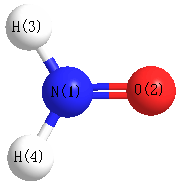Jump to
S1C2
Energy calculated at QCISD(T)/aug-cc-pVDZ
| | hartrees |
|---|
| Energy at 0K | -130.807109 |
| Energy at 298.15K | |
| HF Energy | -130.418614 |
| Nuclear repulsion energy | 34.816419 |
The energy at 298.15K was derived from the energy at 0K
and an integrated heat capacity that used the calculated vibrational frequencies.
Vibrational Frequencies calculated at QCISD(T)/aug-cc-pVDZ
| Mode Number |
Symmetry |
Frequency
(cm-1) |
Scaled Frequency
(cm-1) |
IR Intensities
(km mol-1) |
Raman Act
(Å4/u) |
Dep P |
Dep U |
|---|
| 1 |
A1 |
3446 |
3370 |
|
|
|
|
| 2 |
A1 |
1659 |
1622 |
|
|
|
|
| 3 |
A1 |
1368 |
1338 |
|
|
|
|
| 4 |
B1 |
318i |
311i |
|
|
|
|
| 5 |
B2 |
3598 |
3518 |
|
|
|
|
| 6 |
B2 |
1249 |
1221 |
|
|
|
|
Unscaled Zero Point Vibrational Energy (zpe) 5501.0 cm
-1
Scaled (by 0.9778) Zero Point Vibrational Energy (zpe) 5378.9 cm
-1
See section
III.C.1 List or set vibrational scaling factors
to change the scale factors used here.
See section
III.C.2
Calculate a vibrational scaling factor for a given set of molecules
to determine the least squares best scaling factor.
Geometric Data calculated at QCISD(T)/aug-cc-pVDZ
Point Group is C2v
Cartesians (Å)
| Atom |
x (Å) |
y (Å) |
z (Å) |
|---|
| N1 |
0.000 |
0.000 |
-0.546 |
| O2 |
0.000 |
0.000 |
0.741 |
| H3 |
0.000 |
0.886 |
-1.052 |
| H4 |
0.000 |
-0.886 |
-1.052 |
Atom - Atom Distances (Å)
| |
N1 |
O2 |
H3 |
H4 |
| N1 | | 1.2872 | 1.0202 | 1.0202 |
O2 | 1.2872 | | 1.9999 | 1.9999 | H3 | 1.0202 | 1.9999 | | 1.7718 | H4 | 1.0202 | 1.9999 | 1.7718 | |
 More geometry information
More geometry information
Calculated Bond Angles
| atom1 |
atom2 |
atom3 |
angle |
|
atom1 |
atom2 |
atom3 |
angle |
| O2 |
N1 |
H3 |
119.725 |
|
O2 |
N1 |
H4 |
119.725 |
| H3 |
N1 |
H4 |
120.550 |
|
Electronic energy levels
Charges, Dipole, Quadrupole and Polarizability
Jump to
S1C1
Energy calculated at QCISD(T)/aug-cc-pVDZ
| | hartrees |
|---|
| Energy at 0K | -130.807316 |
| Energy at 298.15K | -130.809713 |
| HF Energy | -130.419189 |
| Nuclear repulsion energy | 34.766259 |
The energy at 298.15K was derived from the energy at 0K
and an integrated heat capacity that used the calculated vibrational frequencies.
Vibrational Frequencies calculated at QCISD(T)/aug-cc-pVDZ
| Mode Number |
Symmetry |
Frequency
(cm-1) |
Scaled Frequency
(cm-1) |
IR Intensities
(km mol-1) |
Raman Act
(Å4/u) |
Dep P |
Dep U |
|---|
| 1 |
A' |
3417 |
3341 |
|
|
|
|
| 2 |
A' |
1650 |
1613 |
|
|
|
|
| 3 |
A' |
1351 |
1321 |
|
|
|
|
| 4 |
A' |
432 |
423 |
|
|
|
|
| 5 |
A" |
3564 |
3485 |
|
|
|
|
| 6 |
A" |
1265 |
1237 |
|
|
|
|
Unscaled Zero Point Vibrational Energy (zpe) 5839.5 cm
-1
Scaled (by 0.9778) Zero Point Vibrational Energy (zpe) 5709.9 cm
-1
See section
III.C.1 List or set vibrational scaling factors
to change the scale factors used here.
See section
III.C.2
Calculate a vibrational scaling factor for a given set of molecules
to determine the least squares best scaling factor.
Geometric Data calculated at QCISD(T)/aug-cc-pVDZ
Point Group is Cs
Cartesians (Å)
| Atom |
x (Å) |
y (Å) |
z (Å) |
|---|
| N1 |
-0.023 |
0.550 |
0.000 |
| O2 |
-0.023 |
-0.740 |
0.000 |
| H3 |
0.174 |
1.034 |
0.879 |
| H4 |
0.174 |
1.034 |
-0.879 |
Atom - Atom Distances (Å)
| |
N1 |
O2 |
H3 |
H4 |
| N1 | | 1.2905 | 1.0223 | 1.0223 |
O2 | 1.2905 | | 1.9895 | 1.9895 | H3 | 1.0223 | 1.9895 | | 1.7578 | H4 | 1.0223 | 1.9895 | 1.7578 | |
 More geometry information
More geometry information
Calculated Bond Angles
| atom1 |
atom2 |
atom3 |
angle |
|
atom1 |
atom2 |
atom3 |
angle |
| O2 |
N1 |
H3 |
118.215 |
|
O2 |
N1 |
H4 |
118.215 |
| H3 |
N1 |
H4 |
118.575 |
|
Electronic energy levels
Charges, Dipole, Quadrupole and Polarizability
